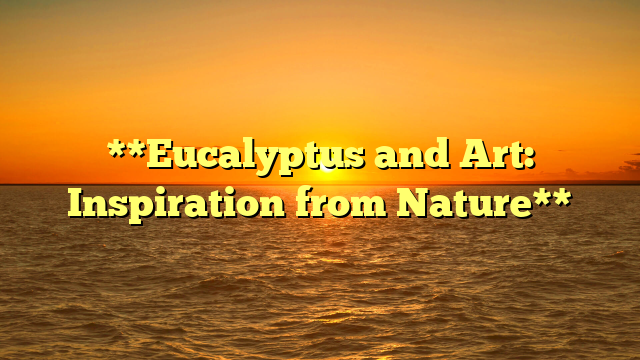
solotogel , with their distinct appearance and aromatic leaves, have long been a source of inspiration for artists around the world. Native to Australia, these trees are not only admired for their ecological benefits and medicinal properties but also for their unique aesthetic qualities. The eucalyptus tree, with its smooth bark, elongated leaves, and vibrant colors, has captured the imagination of artists in various forms, including painting, sculpture, photography, and even literature. This article explores the connection between eucalyptus and art, examining how this remarkable plant has inspired creativity in different artistic disciplines.
**1. Eucalyptus in Visual Arts**
The visual arts, particularly painting, have a deep connection with the natural world, and eucalyptus trees are no exception. Their striking form and the way light interacts with their foliage have made them a subject of interest for artists. In the 19th and 20th centuries, many Australian artists, such as *Albert Namatjira* and *Margaret Preston*, depicted the eucalyptus tree as a symbol of the Australian landscape.
Namatjira, one of Australia’s most celebrated Indigenous artists, was known for his watercolor landscapes that often featured the iconic eucalyptus tree. His works captured the light and textures of the tree’s bark and leaves, showcasing the eucalyptus as an essential part of the Australian wilderness. Similarly, Margaret Preston, an influential modernist artist, frequently incorporated eucalyptus in her still life paintings, bringing the beauty of the Australian flora to the forefront of the visual art scene.
The eucalyptus tree’s smooth, peeling bark and the fluid movement of its long leaves make it a subject well-suited for artists working in both abstract and realistic styles. The varying shades of green, silver, and gray in the leaves provide a dynamic palette for artists, while the intricate patterns of the tree’s bark offer a textured surface for exploration. Many contemporary artists continue to be inspired by eucalyptus, drawing on its natural beauty to explore themes of identity, place, and the environment.
**2. Eucalyptus in Sculpture**
In addition to painting, eucalyptus trees also inspire sculptors who are drawn to the tactile nature of the wood. The eucalyptus tree is known for its hard, dense wood, making it an ideal material for carving. Eucalyptus wood is often used in the creation of sculptures, especially in Australia, where it is readily available. The natural patterns in the wood, combined with its durability and texture, offer a unique medium for sculptural expression.
Artists working with eucalyptus wood often highlight the tree’s organic curves and distinctive grain patterns. The smoothness of its bark, with its peeling layers, can also be used to create sculptures that reflect the tree’s transformative nature. Whether carved into lifelike representations of the tree itself or abstract forms, eucalyptus wood provides sculptors with a material that is both challenging and rewarding.
**3. Eucalyptus in Photography**
The striking visual appeal of eucalyptus trees also makes them a popular subject for photographers. Whether captured in the wilderness or in an urban setting, eucalyptus trees create a striking contrast against various backdrops. The way their silvery leaves catch the light, especially during sunrise or sunset, provides photographers with an opportunity to explore light, shadow, and texture.
Eucalyptus trees often appear in both black-and-white and color photography, allowing photographers to experiment with contrasts, shapes, and perspectives. Photographers also frequently capture the movement of eucalyptus leaves in the wind, emphasizing their fluidity and the natural rhythms of the landscape. The eucalyptus tree’s ability to stand out in diverse environments has made it a favorite subject for photographers seeking to explore the beauty of nature through the lens.
**4. Eucalyptus and Literature**
Beyond visual arts and sculpture, eucalyptus trees have also inspired writers and poets. In Australian literature, the eucalyptus tree is often symbolically tied to the national identity and landscape. Poets and authors use the image of the eucalyptus to evoke feelings of connection to the land, solitude, and even resilience.
For example, the famous Australian poet *Dorothea Mackellar* used the imagery of eucalyptus trees in her work “My Country,” capturing the essence of the Australian landscape. Eucalyptus trees are often referenced in literature to evoke a sense of place and a deep connection to nature. Their timeless presence in the Australian bush provides a source of reflection for many writers who look to nature for inspiration.
**5. Eucalyptus and Environmental Art**
In recent years, environmental artists have turned to eucalyptus trees as a way of engaging with issues related to conservation and climate change. These artists use eucalyptus as a symbol of both natural beauty and the challenges facing the environment. The eucalyptus tree’s rapid growth and ability to adapt to various environments have made it an interesting subject for artists exploring themes of sustainability and ecological balance.
Some environmental artists work with the eucalyptus tree itself, incorporating its leaves, branches, or bark into installations and mixed-media works. Others use the symbolism of eucalyptus to draw attention to environmental issues, such as deforestation and habitat loss, using their art to advocate for the preservation of natural landscapes.
Eucalyptus trees have proven to be a rich source of inspiration for artists across various disciplines. Whether through their visual appeal, the textures of their bark, or their symbolic representation of the Australian landscape, eucalyptus trees have played an integral role in the world of art. From traditional painting and sculpture to contemporary photography and environmental art, the eucalyptus continues to captivate the creative imagination. Its presence in art not only highlights its aesthetic beauty but also serves as a reminder of the importance of nature in our lives and the power of the natural world to inspire human creativity.




